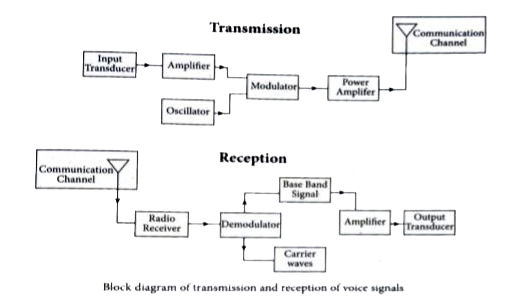Elaborate on the basic elements of communication system with the necessary block diagram. Solution in Tamil
Elements of an electronic communication system
• Information (Baseband or input signal)
Information can be in the form of a sound signal like speech, music, pictures, or computer data which is given as input to the input transducer.

• Input transducer
A transducer is a device that converts variations in a physical quantity (pressure, temperature, sound) into an equivalent electrical signal or vice versa. In communication system, the transducer converts the information which is in the form of sound, music, pictures or computer data into corresponding electrical signals. The electrical equivalent of the original information is called the baseband signal. The best example for the transducer is the microphone that converts sound energy into electrical energy.
• Transmitter
It feeds the electrical signal from the transducer to the communication channel. It consists of circuits such as amplifier, oscillator, modulator, and power amplifier. The transmitter is located at the broadcasting station.
Amplifier: The transducer output is very weak and is amplified by the amplifier.
Oscillator: It generates high-frequency carrier wave (a sinusoidal wave) for long distance transmission into space. As the energy of a wave is proportional to its frequency, the carrier wave has very high energy.
Modulator: It superimposes the baseband signal onto the carrier signal and generates the modulated signal.
Power amplifier: It increases the power level of the electrical signal in order to cover a large distance.
• Transmitting antenna
It radiates the radio signal into space in all directions. It travels in the form of electromagnetic waves with the velocity of light (3×108ms−1)
. • Communication channel
Communication channel is used to carry the electrical signal from transmitter to receiver with less noise or distortion. The communication medium is basically of two types: wireline communication and wireless communication.
• Noise
It is the undesirable electrical signal that interfaces with the transmitted signal. Noise attenuates or reduces the quality of the transmitted signal. It may be man-made (automobiles, welding machines, electric motors etc.) or natural (lightening, radiation from sun and stars and environmental effects). Noise cannot be completely eliminated. However, it can be reduced using various techniques.
• Receiver
The signals that are transmitted through the communication medium are received with the help of a receiving antenna and are fed into the receiver. The receiver consists of electronic circuits like demodulator, amplifier, detector etc. The demodulator extracts the baseband signal from the carrier signal. Then the baseband signal is detected and amplified using amplifiers. Finally, it is fed to the output transducer.
• Repeaters
Repeaters are used to increase the range or distance through which the signals are sent. It is a combination of transmitter and receiver. The signals are received, amplified, and retransmitted with a carrier signal of different frequency to the destination. The best example is the communication satellite in space.
• Output transducer
It converts the electrical signal back to its original form such as sound, music, pictures or data. Examples of output transducers are loudspeakers, picture tubes, computer monitor, etc.
• Attenuation
The loss of strength of a signal while propagating through a medium is known as attenuation.
• Range
It is the maximum distance between the source and the destination up to which the signal is received with sufficient strength.
Topper's Solved these Questions
Similar Questions
Derive an expression for the torque experienced by a dipole due to a uniform electric field.
View SolutionDerive an expression for electrostatic potential due to an electric dipole.
View SolutionDerive an expression for electrostatic potential energy of the dipole in a uniform electric field .
View Solutionरेडियो संचार व्यवस्था का योजनाबद्ध ब्लॉक आरेख बनाइये।
View Solutionसंचार व्यवस्था के आवश्यक तत्व क्या है। एक ब्लॉक आरेख खींचकर संक्षेप में समझायें।
View SolutionDraw the block diagram of a receiver in communication system.
View SolutionDraw a block diagram of generalized communications system.
View SolutionWhat are the basic blocks of a communication system ?
View Solutionसंचार तंत्र का ब्लॉक आरेख बनाइए।
View SolutionElaborate on the basic elements of communication system with the necessary block diagram.
View SolutionDraw the block diagram of generalised communication system.
View SolutionDraw a block diagram of a communication system.
View SolutionElaborate on the basic elements of communication system with the necessary block diagram.
View SolutionDraw a labelled block diagram of a basic communication system.
View SolutionExplain basic elements of communication system with the help of block diagram.
View Solution

